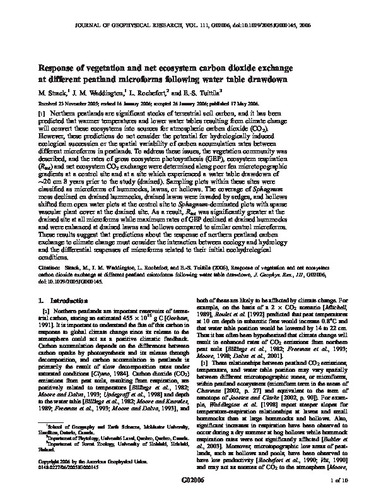| dc.contributor.author | Strack, Maria | |
| dc.contributor.author | Waddington, James M. | |
| dc.contributor.author | Rochefort, Line | |
| dc.contributor.author | Tuittila, Eeva-Stiina | |
| dc.date.accessioned | 2023-03-21 19:19:18 (GMT) | |
| dc.date.available | 2023-03-21 19:19:18 (GMT) | |
| dc.date.issued | 2006-05-17 | |
| dc.identifier.uri | https://doi.org/10.1029/2005JG000145 | |
| dc.identifier.uri | http://hdl.handle.net/10012/19223 | |
| dc.description | This is the peer reviewed version of the following article: Strack, M., Waller, M.F. and Waddington, J.M. 2006. Sedge succession and peatland methane dynamics: A potential feedback to climate change. Ecosystems, 9, 278-287., which has been published in final form at https://doi.org/10.1029/2005JG000145. This article may be used for non-commercial purposes in accordance with Wiley Terms and Conditions for Use of Self-Archived Versions. This article may not be enhanced, enriched or otherwise transformed into a derivative work, without express permission from Wiley or by statutory rights under applicable legislation. Copyright notices must not be removed, obscured or modified. The article must be linked to Wiley’s version of record on Wiley Online Library and any embedding, framing or otherwise making available the article or pages thereof by third parties from platforms, services and websites other than Wiley Online Library must be prohibited. | en |
| dc.description.abstract | Northern peatlands are significant stocks of terrestrial soil carbon, and it has been predicted that warmer temperatures and lower water tables resulting from climate change will convert these ecosystems into sources for atmospheric carbon dioxide (CO2). However, these predictions do not consider the potential for hydrologically induced ecological succession or the spatial variability of carbon accumulation rates between different microforms in peatlands. To address these issues, the vegetation community was described, and the rates of gross ecosystem photosynthesis (GEP), ecosystem respiration (Rtot) and net ecosystem CO2 exchange were determined along poor fen microtopographic gradients at a control site and at a site which experienced a water table drawdown of 20 cm 8 years prior to the study (drained). Sampling plots within these sites were classified as microforms of hummocks, lawns, or hollows. The coverage of Sphagnum moss declined on drained hummocks, drained lawns were invaded by sedges, and hollows shifted from open water plots at the control site to Sphagnum-dominated plots with sparse vascular plant cover at the drained site. As a result, Rtot was significantly greater at the drained site at all microforms while maximum rates of GEP declined at drained hummocks and were enhanced at drained lawns and hollows compared to similar control microforms. These results suggest that predictions about the response of northern peatland carbon exchange to climate change must consider the interaction between ecology and hydrology and the differential responses of microforms related to their initial ecohydrological conditions. | en |
| dc.description.sponsorship | This research was funded by NSERC (Canada) and Canadian Foundation for Climate and Atmospheric Science (CFCAS) grants to J.M.W., NSERC Julie Payette and CGS scholarships to M.S., and a postdoctoral grant from the Academy of Finland (project 12328) and from the Faculty des Sciences de l'Agriculture et de l'Alimentation, Université Laval, to E.T. | en |
| dc.language.iso | en | en |
| dc.publisher | American Geophysical Union, Wiley | en |
| dc.relation.ispartofseries | Journal of Geophysical Research Biogeosciences; | |
| dc.subject | carbon dioxide | en |
| dc.subject | climate change | en |
| dc.subject | ecological succession | en |
| dc.subject | net ecosystem CO2 exchange | en |
| dc.subject | peatland | en |
| dc.subject | water table drawdown | en |
| dc.title | Response of vegetation and net ecosystem carbon dioxide exchange at different peatland microforms following water table drawdown | en |
| dc.type | Article | en |
| dcterms.bibliographicCitation | Strack, M., Waddington, J.M., Rochefort, L. and Tuittila, E.-S. 2006. Response of vegetation and carbon dioxide exchange at different peatland microforms following water table drawdown. Journal of Geophysical Research-Biogeosciences, 111, G02006, doi: 10.1029/2005JG000145 | en |
| uws.contributor.affiliation1 | Faculty of Environment | en |
| uws.contributor.affiliation2 | Geography and Environmental Management | en |
| uws.typeOfResource | Text | en |
| uws.peerReviewStatus | Reviewed | en |
| uws.scholarLevel | Faculty | en |

